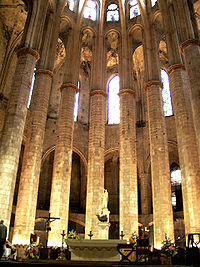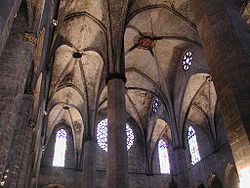.gif)
Santa Maria del Mar (Barcelona)
Encyclopedia
This article is about the church in Barcelona. For other uses, see Santa María del Mar (disambiguation)
.

 Santa Maria del Mar (ˈsantə məˈɾi.ə ðəɫ ˈmar) is an imposing church in the Ribera
Santa Maria del Mar (ˈsantə məˈɾi.ə ðəɫ ˈmar) is an imposing church in the Ribera
district of Barcelona
, Spain, built between 1329 and 1383 at the height of Catalonia
's maritime and mercantile preeminence. It is an outstanding example of Catalan Gothic
, with a purity and unity of style that are very unusual in large mediaeval buildings.
of Santa Maria in 1324. Construction work started on 25 March 1329, when the foundation stone was laid by king Alfonso IV of Aragon
, as commemorated by a tablet in Latin and Catalan on the facade that gives onto Fossar de les Moreres
. The architects in charge were Berenguer de Montagut
(designer of the building) and Ramon Despuig
, and during the construction all the guilds of the Ribera quarter were involved. The walls, the side chapels and the facades were finished by 1350. In 1379 there was a fire that damaged important parts of the works. Finally, on 3 November 1383 the last stone was added and on 15 August the first mass was celebrated. In 1428 an earthquake caused several casualties and destroyed the rose window
in the west end. The new window, in the Flamboyant
style, was finished by 1459 and one year later the glass was added. The images and the Baroque altar were destroyed in a fire in 1936. The chapel of the Blessed Sacrament, adjacent to the apse, was added in the 19th century.
The north-west tower was completed in 1496, but its companion was not finished until 1902.;

type, with its three aisles forming a single space with no transept
s and no architectural boundary between nave
and presbytery. The simple ribbed vault
is supported on slender octagonal columns, and abundant daylight streams in through the tall clerestorey windows.
The interior is almost devoid of imagery of the sort to be found in Barcelona's other large Gothic churches, the cathedral
and Santa Maria del Pi
, after the fire which occurred in 1936 during anticlerical disturbances. Amongst the most notable of the works destroyed at that time was the Baroque retable by Deodat Casanoves and Salvador Gurri.
Some interesting stained-glass windows have survived from various periods.
 The church has a serious claim to have the slenderest stone built columns in the world.
The church has a serious claim to have the slenderest stone built columns in the world.
, by Ildefonso Falcones
(2006).
Santa María del Mar (disambiguation)
*Santa María del Mar , a district in southern Lima, Peru*Santa María del Mar , a beach in the Habana del Este municipality of Havana, Cuba*Santa María del Mar, Oaxaca, a seaside community in Mexico...
.


La Ribera
La Ribera is one of the areas of the quarter of Sant Pere, Santa Caterina i la Ribera of Ciutat Vella of Barcelona.Many of the buildings date from late Medieval times. It was a well-to-do quarter during 13th-15th centuries, when it really was by the sea shore, and the area that today is named...
district of Barcelona
Barcelona
Barcelona is the second largest city in Spain after Madrid, and the capital of Catalonia, with a population of 1,621,537 within its administrative limits on a land area of...
, Spain, built between 1329 and 1383 at the height of Catalonia
Catalonia
Catalonia is an autonomous community in northeastern Spain, with the official status of a "nationality" of Spain. Catalonia comprises four provinces: Barcelona, Girona, Lleida, and Tarragona. Its capital and largest city is Barcelona. Catalonia covers an area of 32,114 km² and has an...
's maritime and mercantile preeminence. It is an outstanding example of Catalan Gothic
Gothic architecture
Gothic architecture is a style of architecture that flourished during the high and late medieval period. It evolved from Romanesque architecture and was succeeded by Renaissance architecture....
, with a purity and unity of style that are very unusual in large mediaeval buildings.
History
The first mention of a church of Santa Maria by the sea dates from 998. The construction of the present building was promoted by the canon Bernat Llull, who was appointed ArchdeanArchdean
Archdean is a discontinued Catholic ecclesiastical officeEven in the 20th century it was maintained as a dignity among the canons of a cathedral chapters, occasionally alongside a dean .* Not to be confused with Archdeacon...
of Santa Maria in 1324. Construction work started on 25 March 1329, when the foundation stone was laid by king Alfonso IV of Aragon
Alfonso IV of Aragon
Alfonso IV, called the Kind was the King of Aragon and Count of Barcelona from 1327 to his death. He was the second son of James II and Blanche of Anjou...
, as commemorated by a tablet in Latin and Catalan on the facade that gives onto Fossar de les Moreres
Fossar de les Moreres
The Fossar de les Moreres is a memorial plaza in Barcelona , adjacent to the basilica of Santa Maria del Mar. The plaza was built over a cemetery where defenders of the city were buried following the Siege of Barcelona at the end of the War of the Spanish Succession in 1714...
. The architects in charge were Berenguer de Montagut
Berenguer de Montagut
Berenguer de Montagut was a Catalan architect, master builder on Santa Maria del Mar.Little is known about Berenguer de Montagut's life...
(designer of the building) and Ramon Despuig
Ramon Despuig
Fra' Ramon Despuig was the 67th Prince and Grand Master of the Order of Malta. He was elected to the position in 1736 and served for 5 years until his death. He was succeeded by Manuel Pinto da Fonseca. During his reign, the legislation the small state was renewed and the Cathedral of St. John ...
, and during the construction all the guilds of the Ribera quarter were involved. The walls, the side chapels and the facades were finished by 1350. In 1379 there was a fire that damaged important parts of the works. Finally, on 3 November 1383 the last stone was added and on 15 August the first mass was celebrated. In 1428 an earthquake caused several casualties and destroyed the rose window
Rose window
A Rose window is often used as a generic term applied to a circular window, but is especially used for those found in churches of the Gothic architectural style and being divided into segments by stone mullions and tracery...
in the west end. The new window, in the Flamboyant
Flamboyant
Flamboyant is the name given to a florid style of late Gothic architecture in vogue in France from the 14th to the early 16th century, a version of which spread to Spain and Portugal during the 15th century; the equivalent stylistic period in English architecture is called the Decorated Style, and...
style, was finished by 1459 and one year later the glass was added. The images and the Baroque altar were destroyed in a fire in 1936. The chapel of the Blessed Sacrament, adjacent to the apse, was added in the 19th century.
Exterior
From the outside, Santa Maria gives an impression of massive severity that belies the interior. It is hemmed in by the narrow streets of the Ribera, making it difficult to obtain an overall impression, except from the Fossar de les Moreres and the Plaça de Santa Maria, both of them former burial grounds. The latter is dominated by the west end of the church with its rose window. Images of Saint Peter and Saint Paul occupy niches on either side of the west door, and the tympanum shows the Saviour flanked by Our Lady and Saint John.The north-west tower was completed in 1496, but its companion was not finished until 1902.;

Interior
In contrast with the exterior, the interior gives an impression of light and spaciousness. It is of the basilicaBasilica
The Latin word basilica , was originally used to describe a Roman public building, usually located in the forum of a Roman town. Public basilicas began to appear in Hellenistic cities in the 2nd century BC.The term was also applied to buildings used for religious purposes...
type, with its three aisles forming a single space with no transept
Transept
For the periodical go to The Transept.A transept is a transverse section, of any building, which lies across the main body of the building. In Christian churches, a transept is an area set crosswise to the nave in a cruciform building in Romanesque and Gothic Christian church architecture...
s and no architectural boundary between nave
Nave
In Romanesque and Gothic Christian abbey, cathedral basilica and church architecture, the nave is the central approach to the high altar, the main body of the church. "Nave" was probably suggested by the keel shape of its vaulting...
and presbytery. The simple ribbed vault
Vault (architecture)
A Vault is an architectural term for an arched form used to provide a space with a ceiling or roof. The parts of a vault exert lateral thrust that require a counter resistance. When vaults are built underground, the ground gives all the resistance required...
is supported on slender octagonal columns, and abundant daylight streams in through the tall clerestorey windows.
The interior is almost devoid of imagery of the sort to be found in Barcelona's other large Gothic churches, the cathedral
Cathedral of Santa Eulalia
The Cathedral of the Holy Cross and Saint Eulalia , also known as Barcelona Cathedral, is the Gothic cathedral and seat of the Archbishop of Barcelona, Spain. The cathedral was constructed throughout the 13th to 15th centuries, with the principal work done in the 14th century. The cloister, which...
and Santa Maria del Pi
Santa María del Pí, Barcelona
Santa Maria del Pi is a 14th century Gothic church in Barcelona, Catalonia, Spain. It is situated on the Plaça del Pi, in the Barri Gòtic district of the city.- History :...
, after the fire which occurred in 1936 during anticlerical disturbances. Amongst the most notable of the works destroyed at that time was the Baroque retable by Deodat Casanoves and Salvador Gurri.
Some interesting stained-glass windows have survived from various periods.

Proportions
According to the art historian Josep Bracons, the basic unit of measurement used in Santa Maria del Mar was the mediaeval foot of 33 centimetres. Measured in this way, the side chapels are 10 feet deep, the width of the side aisles is double this, while the central aisle is four times as wide, that is, 40 feet. The total width of the church is thus 100 mediaeval feet, which is also equal to the maximum height of the building.In popular culture
The construction of Santa Maria del Mar is the background for the best-selling novel La catedral del marCathedral of the sea
Cathedral of the Sea is a historical novel by Spanish author Ildefonso Falcones. The action takes place in 14th century Barcelona at the height of the Inquisition, with the construction of Santa Maria del Mar serving as background to the story....
, by Ildefonso Falcones
Ildefonso Falcones
Ildefonso Falcones is a Spanish lawyer and writer from Barcelona.He became famous with the historical thriller Cathedral of the Sea, published in 2006, and set in medieval Barcelona. His second novel is La mano de Fátima .-References:...
(2006).

